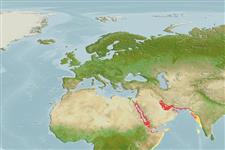Environment: milieu / climate zone / ระดับความลึก / distribution range
นิเวศวิทยา
เกี่ยวกับทะเล,น้ำเค็ม เกี่ยวกับหินโสโครก; ระดับความลึก 3 - 50 m (Ref. 9710). Tropical
Western Indian Ocean: Red Sea and the Gulf of Aden.
ขนาด / น้ำหนัก / Age
วัยเจริญพันธุ์: Lm ? range ? - ? cm
Max length : 18.0 cm TL เพศผู้/กระเทย; (Ref. 9710)
Short description
เครื่องมือที่ใช้ในการแยกชนิดสัตว์,สิ่งมีชีวิตออกจากกัน | สัณฐานวิทยา | ความยาวต่างๆ
Found on coral slopes (Ref. 9710) Juveniles in large groups at base of reef, sometimes with H. diphreutes; adults usually solitary or paired, occasionally in groups (Ref. 9710). Feed on zooplankton and benthic invertebrates (Ref. 9710). Oviparous (Ref. 205), monogamous (Ref. 52884). Form pairs during breeding (Ref. 205).
Life cycle and mating behavior
วัยเจริญพันธุ์ | การสืบพันธุ์ | การวางไข่ | เซลสืบพันธ์ของเพศเมีย(ไข่) | ความดกของไข่ | ตัวอ่อน
Distinct pairing (Ref. 205). Monogamous mating is observed as both obligate and social (Ref. 52884).
Robins, C.R., R.M. Bailey, C.E. Bond, J.R. Brooker, E.A. Lachner, R.N. Lea and W.B. Scott, 1991. World fishes important to North Americans. Exclusive of species from the continental waters of the United States and Canada. Am. Fish. Soc. Spec. Publ. (21):243 p. (Ref. 4537)
IUCN Red List Status (Ref. 130435: Version 2025-1)
Threat to humans
Harmless
Human uses
การประมง: การค้า; สถานที่แสดงสัตว์และพืชน้ำ: การค้า
เครื่องมือ
Special reports
Download XML
แหล่งที่มาจากอินเตอร์เน็ต
Estimates based on models
Preferred temperature (อ้างอิง
123201): 24.7 - 29.4, mean 27 °C (based on 130 cells).
Phylogenetic diversity index (อ้างอิง
82804): PD
50 = 0.5039 [Uniqueness, from 0.5 = low to 2.0 = high].
Bayesian length-weight: a=0.01995 (0.00906 - 0.04395), b=3.01 (2.83 - 3.19), in cm total length, based on all LWR estimates for this body shape (Ref.
93245).
ระดับชั้นอาหาร (อ้างอิง
69278): 3.5 ±0.41 se; based on food items.
ความสามารถในการกลับคืนสู่ปกติ (อ้างอิง
120179): ความสูง, เวลาต่ำสุดที่จะทำให้ประชากรเพิ่มขึ้นเป็น 2 เท่าใช้เวลาน้อยกว่า 15 เดือน (Preliminary K or Fecundity.).
Fishing Vulnerability (Ref.
59153): Low vulnerability (10 of 100).
🛈
Nutrients (Ref.
124155): Calcium = 92.2 [47.9, 143.6] mg/100g; Iron = 0.784 [0.462, 1.285] mg/100g; Protein = 18.7 [17.6, 19.8] %; Omega3 = 0.126 [0.077, 0.200] g/100g; Selenium = 34.4 [19.3, 64.5] μg/100g; VitaminA = 51.1 [15.1, 167.6] μg/100g; Zinc = 1.3 [0.9, 1.9] mg/100g (wet weight);
